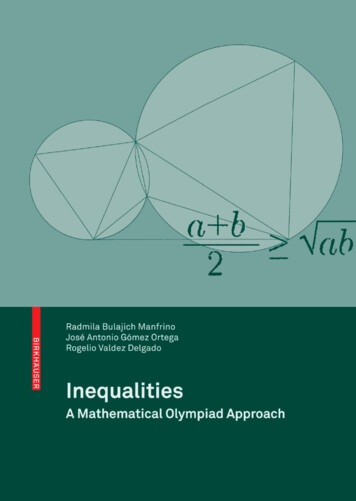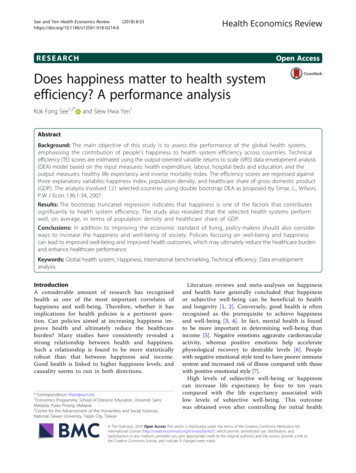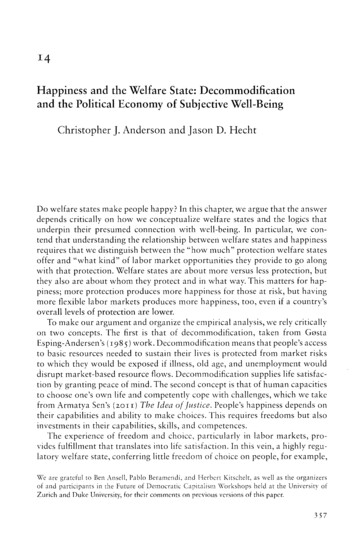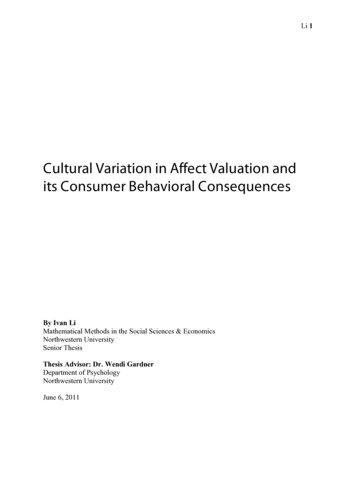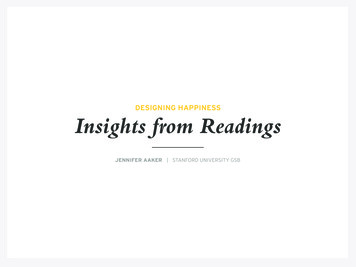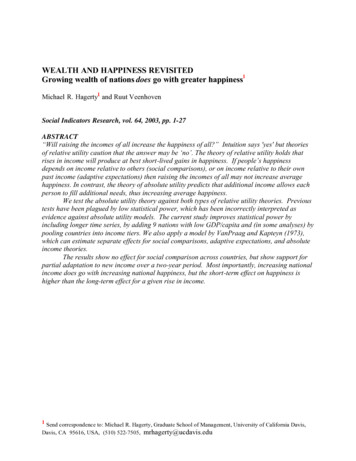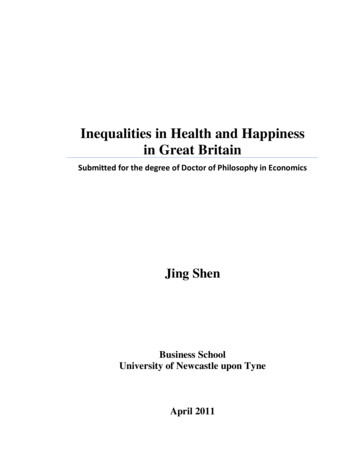
Transcription
Inequalities in Health and Happinessin Great BritainSubmitted for the degree of Doctor of Philosophy in EconomicsJing ShenBusiness SchoolUniversity of Newcastle upon TyneApril 2011
To my parents and my grandmother,with all my loveii
AbstractThe PhD thesis investigates the issue of inequalities in health and happiness in Britain.Consisting of three empirical studies and one piece of conceptual modelling, the researchundertakes new investigations into health inequalities using longitudinal data. Carried outfrom a new angle – the life-course perspective, the studies adopt new methods includingentropy measures, relative distributions and quantile regression to examine inequalities inthe broader sense of health – mental health, psychological wellbeing and the relatedconcept of happiness, in addition to physical health.Robust and reliable measures of inequalities in health should first be established beforeany investigations of health inequalities being carried out and this research shows thatnew methods need to be applied in addition to the traditional methods in order toovercome the flaws of the old methods and provide new insights into the issue of healthinequalities. The life-course approach reveals that parental income and birth weight playimportant roles in respondents’ adulthood health inequality in addition to a range ofsocioeconomic factors, although parental income is only significant in wave 7 whereasbirth weight is only significant and has more contribution in wave 4. With the applicationof the relative distributions method, the empirical study identifies that shape changerather than location change in the self-assessed health (SAH) distribution causes loweraverage SAH. Extending the analysis of inequalities in physical health to psychologicalwellbeing, women in England are found to be less happy than men mainly due topolarization occurring in the female population compared to men. Both the relativedistributions method and quantile regression have confirmed the effects of somesocioeconomic factors on psychological wellbeing and extended to happiness, however,the general trend of the psychological side of health or happiness over time cannot beconcluded. Nevertheless, the relative distributions method is shown to perform well inunderstanding how the psychological health variable is distributed across the entiredistribution over time. This research also contributes to a further examination of therelationship between income inequality and health, and the results continue to be mixed,although longstanding illness and Malaise Inventory appear to be more affected byincome inequality than SAH and the choice of different indicators of income inequalityseems to be important. Furthermore, a conceptual model is established in the thesis toprovide a better understanding of the concepts involving health and happiness, which isbelieved to be the first attempt of its kind in the literature.iii
ContentsAcknowledgement. 1Chapter One: Introduction . 31.1 Research background . 31.2 Study aims and originality. 71.3 Structure of the thesis. 9Part I Health, Health Inequalities and Income InequalityChapter Two: Concepts of health inequalities . 132.1 Introduction . 132.2 Inevitable or unacceptable health inequalities. 132.3 Health inequalities: the evidence . 162.4 Production of health. 172.5 Determinants of health . 182.6 Life-course approach. 212.7 Summary . 23Chapter Three: Measurements of health inequalities . 263.1 Introduction . 263.2 Overview of conventional health inequalities measures. 263.3 Commonly used methods to measure health inequalities . 333.3.1 Gini and Lorenz curve. 333.3.2 Concentration index and concentration curve . 353.3.3 Decomposition of concentration index. 363.4 New methods to measure health inequalities . 383.4.1 Entropy measures. 383.4.1.1 Theil’s entropy . 393.4.1.2 H measure . 403.4.1.3 B measure. 403.4.2 Relative distributions method . 413.5 Summary . 47Chapter Four: Comparing different measures of health inequalities . 484.1 Introduction . 484.2 Data . 484.3 Self-assessed health as health outcome indicator . 504. 4 Results . 514.4.1 Descriptive analysis of self-assessed health . 514.4.2 Gini and Lorenz curves . 544.4.3 Concentration index and curves. 564.4.4 Concentration index of dichotomized SAH. 594.4.5 Decomposition of concentration index. 614.4.5.1 Attrition and robustness check . 644.4.5.2 Decomposition of concentration index calculated using permanent parentalincome . 674.4.5.3 Decomposition of concentration index calculated using wave specificcohort member’s own income . 724.4.6 Relative distributions. 764.5 Summary and discussion. 77Chapter Five: Income inequality and health . 835.1 Introduction . 835.2 Recent development of income inequality and health . 835.3 Income inequality over time. 875.4 Estimation strategy. 895.5 Data . 90iv
5.5.1 Health measures . 905.5.2 Reginal variables. 915.6 Results . 915.7 Summary . 97Part II. Health and WellbeingChapter Six: Health, psychological wellbeing and happiness . 1046.1 Introduction . 1046.2 Background. 1046.3 Literature review. 1066.4 A conceptual model of health and happiness . 1086.4.1 Definition of happiness . 1096.4.2 Definitions of health. 1106.4.3 The conceptual model . 1126.5 Summary . 117Chapter Seven: Changes of psychological wellbeing over time in England . 1187.1 Introduction . 1187.2 The indicator of psychological wellbeing . 1187.3 Methods. 1207.3.1 The relative distributions method . 1207.3.2 Quantile regression. 1217.4 Data . 1237.5 Descriptive analysis . 1247.5.1 Descriptive analysis of GHQ . 1247.5.2 Descriptive analysis of key social demographic covariates . 1297.6 Relative distributions results . 1317.6.1 Non-truncated sample. 1337.6.2 Sample truncated at GHQ score of zero . 1377.6.3 Sample truncated at GHQ score of two. 1417.6.4 Male-female comparisons. 1447.7 Covariate adjustment. 1487.7.1 Single covariate adjustment – example: 1997-2005 whole sample . 1497.7.1.1 Income adjustment . 1497.7.1.2 Marital status adjustment . 1527.7.1.3 Education adjustment . 1537.7.2 Sequential covariates adjustment . 1567.7.2.1 Example 1: 1997-2005 sample truncated at GHQ score of zero. 1567.7.2.2 Example 2: 1997-2005 sample truncated at GHQ score of two . 1607.8 Quantile regression . 1647.8.1 Quantile regression of the 1997 sample . 1647.8.2 Quantile regression of 2005 sample. 1677.8.3 1997-2005 quintile regression summary . 1697.9 Summary . 171Chapter Eight: Conclusion. 175References . 179Appendices . 200Appendix 1 GHQ & Malaise Inventory questions . 200Appendix 2 Modelling results of relative income hypothesis. 202Appendix 3 Quantile regression results . 267Appendix 4 Frequency of GHQ scores in 1997 and 2005 . 272Appendix 5 Relative distributions results . 273v
List of TablesTable 4.1, Gini, Theil's entropy and B measure.54Table 4.2, Distribution of SAH categories in each wave .56Table 4.3, Concentration indices of each wave.57Table 4.4, T-test for paired comparisons of CI .57Table 4.5, CI on dichotomized SAH .60Table 4.6, Regression results for wave 4 and wave 7 (unbalanced sample).62Table 4.7, Regression results for wave 4 and wave 7 (balanced sample).64Table 4.8, Regression results for wave 4 and wave 7 without initial health stock indicators(unbalanced sample) .65Table 4.9, Regression results for wave 4 and wave 7 without initial health stock indicators(balanced sample) .66Table 4.10, Joint significance Wald test .67Table 4.11, Decomposition of CI using permanent parental income (wave 4) .68Table 4.12, Decomposition of CI using permanent parental income (wave 7) .70Table 4.13, Decomposition of CI using wave specific cohort member’s own income (wave 4).73Table 4.14, Decomposition of CI using wave specific cohort member’s own income (wave 7).74Table 4.15, Polarization indices: wave 4 – wave 7.77Table 5.1, Summary results of income inequality models on SAH.93Table 5.2, Summary results of income inequality models on longstanding illness.95Table 5.3, Summary results of income inequality models on Malaise Inventory .96Table 5.4, Panel data model of Malaise Inventory using deprivation from the mean.97Table 7.1, Sample size of each year .123Table 7.2, Average GHQ scores.125Table 7.3, Summary statistics of key variables .130Table 7.4, Pairs of years carried out for relative distributions comparisons .132Table 7.5, Polarization indices: 1998-1999 non-truncated sample .136Table 7.6, Polarization indices: 2004-2005 sample truncated at GHQ score of zero .140Table 7.7, Polarization indices: 2001-2002 sample truncated at GHQ score of two .144Table 7.8, Polarization indices: 2004 male-female relative distributions .147Table 7.9, Polarization indices: 1997-2005 sample truncated at GHQ score of zero .159Table 7.10, Polarization indices: 1997-2005 sample truncated at GHQ score of two.163Table 7.11, Summary of significant regressors in the quantile regressions.170vi
List of FiguresFigure 3.1, Lorenz curve.34Figure 3.2, Concentration curve.36Figure 4.1, Distribution of SAH in wave 4 .52Figure 4.2, Distribution of SAH in wave 5 .52Figure 4.3, Distribution of SAH in wave 6 .53Figure 4.4, Distribution of SAH in wave 7 .53Figure 4.5, Lorenz curve of each wave .55Figure 4.6, Concentration curves using permanent parental income.58Figure 4.7, Concentration curves using wave specific cohort members' own income.59Figure 4.8, Mean SAH and CI .61Figure 4.9, Relative distributions of SAH between wave 4 and wave 7 .77Figure 6.1, The conceptual model of health and happiness .112Figure 7.1, Average GHQ scores for non-truncated samples .126Figure 7.2, Average GHQ scores for samples truncated at GHQ score of zero .127Figure 7.3, Average GHQ scores for samples truncated at GHQ score of two .128Figure 7.4, 1998-1999 relative distributions for the whole sample .133Figure 7.5, 1998-1999 relative distributions for the male sample.134Figure 7.6, 1998-1999 relative distributions for the female sample.135Figure 7.7, 2004-2005 relative distributions for the whole sample truncated at GHQ score ofzero .137Figure 7.8, 2004-2005 relative distributions for the male sample truncated at GHQ score ofzero .138Figure 7.9, 2004-2005 relative distributions for the female sample truncated at GHQ scoreof zero .139Figure 7.10, 2001-2002 relative distributions for the whole sample truncated at GHQ scoreof two .141Figure 7.11, 2001-2002 relative distributionsfor the male sample truncated at GHQ score oftwo .142Figure 7.12, 2001-2002 relative distributions for the female sample truncated at GHQ scoreof two .143Figure 7.13, 2000 male-female relative distributions for the non-truncated sample.145Figure 7.14, 2000 male-female relative distributions for smple truncated at GHQ score ofzero .146Figure 7.15, 2000 male-female relative distributions for sample truncated at GHQ score oftwo .147vii
Figure 7.16, 1997-2005 relative distributions of income .150Figure 7.17, 1997-2005 relative distributions adjusted for income.151Figure 7.18, 1997-2005 relative distributions of marital status .152Figure 7.19, 1997-2005 relative distributions adjusted for marital status.153Figure 7.20, 1997-2005 relative distributions of education .154Figure 7.21, 1997-2005 relative distributions adjusted for education .154Figure 7.22, 1997-2005 relative distributions of income for sample truncated at GHQ scoreof zero .156Figure 7.23, 1997-2005 relative distributions sequentially adjusted for income for sampletruncated at GHQ score of zero: gender, age, education, marital status, social class, income.157Figure 7.24, Location and shape decomposition of the compositional effect of income.158Figure 7.25, Location and shape decomposition of the residual effect of income .159Figure 7.26, 1997-2005 relative distributions of marital status for sample truncated at GHQscore of two.160Figure 7.27, 1997-2005 relative distributions sequentially adjusted for marital status forsample truncated at GHQ score of two: gender, age, education, income, social class, maritalstatus .161Figure 7.28, Location and shape decomposition of the compositional effect of marital status.162Figure 7.29, Location and shape decomposition of the residual effect of marital status.163Figure 7.30, GHQ distribution of 1997.165Figure 7.31, Quantile regression for GHQ in 1997 sample.166Figure 7.32, GHQ distribution of 2005.167Figure 7.33, Quantile regression for GHQ in 2005 sample.168viii
AcknowledgementFinally my PhD is drawing to an end after more than four years of reading, analysing,writing and editing. In addition to the temporary relief and joy this moment brings me, Imost importantly feel very much indebted to many people who have supported, helped orencouraged me during my PhD research.I would first like to thank my supervisors Professor John Wildman and Professor CamDonaldson. John has been a great teacher and guided me through with his vision andexpertises, and his enthusiasm and encouragement have motivated me through difficulttimes during the PhD. Cam has provided me with valuable guidance and support, both formy PhD and many other academic activities and I am always surprised by his super fastresponse to my questions even when he is away. Without them, this PhD would have notbeen possible to achieve.I am also grateful to the Business School, where I have developed presentation andteaching skills by participating in seminars and contributing to teaching programmes. Igive my special thanks to Professor Michael Jones-Lee, whose enthusiasm and humourhave brought me a lot of joy during my PhD research. He was also very kind to discusswith me on one of my research concepts of “happiness” and offered me help on bothacademic and non-academic matters. I also want to say thank you to members of theEconomics Department in the Business School, especially to: Sue Chilton, Emily Lancsar,Hugh Metcalf, Fan Zhang, Stephen McDonald, Bartosz Gebka and David Barlow.I would like to thank the Health Foundation which was chaired by Cam Donaldson duringthe period of my PhD for funding my PhD for three and half years.I also want to offer my special thanks to Pedro Rosa Dias, who offered immense amountof academic help and encouragement when I was applying for this PhD Studentship andduring my PhD research, and also supported me as a friend.I would like to offer my thanks to the members of the Health Economics group in theInstitute of Health and Society, where I am also part of the team and have been givenencouragement and helpful comments.1
Above all, I am deeply indebted to my family and most importantly to my parents and mygrandmother who have always believed in me and supported me unconditionally. Withoutthem, I would have not been where I am today. Nothing I can say or do can ever thankthem enough.2
Chapter One: Introduction“The health of the people is really the foundation upon which all their happiness andall their powers as a state depend .the health of the people is, in my view, the firstduty of a statesman.”Benjamin Disraeli, Speech (1877)1.1 Research backgroundHealth is one of the most important issues in society. Good health is fundamental to allour lives as health is the bedrock on which we build our family lives, working lives andcommunity lives. Good health is also central to the economy. Every year more than 20million working days are lost due to illness, which is a large burden for business. Ahealthier workforce improves productivity and performance, and reduces healthexpenditure. As the foundation of all the other achievements in the life of any individual,health is productivity, health is prosperity, and health is one of the most valuable assetson which a nation is relying. The objective of good health is twofold: “the best attainableaverage level – goodness – and the smallest feasible differences among individuals andgroups – fairness” (WHO report, 2000). In the pursuit of good health, various measureshave been taken to improve the absolute level of population health, which at the nationallevel is mostly observed by the increasing life expectancy and/or decreasing mortality rate.However, the relative level of health – the difference in health between individuals andgroups, i.e. inequality in health – is often overlooked, despite the fact that the firstrecorded recognition of inequality in health between poor and rich people can date backto 1842 when Chadwick published his “Report into the Sanitary Conditions of theLabouring Population of Great Britain”, describing the appalling conditions endured bypoor people in Britain at the time. At the international level, the issue of health inequalitywas first addressed in the Declaration of Alma-Ata in 1978 (Crombie, 2005), which statedthat “the existing gross inequality in the health status of the people is politically,socially and economically unacceptable”.The fairness of health is at least as important as the overall level of health, which isreflected by the government’s health action report where promoting equality in health islisted as one of the key aims of the Government’s health strategy (Department of Health,3
1999). It is, most important of all, a moral decision to reduce health inequality. Maguid(2002) has pointed out: “One of the most unfair inequalities is disclosed in the right toliving”. As the starting point of Marmot’s recent review on health inequalities in England,he states health inequalities to be morally unacceptable and socially unjust because“inequalities are a matter of life and death, of health and sickness, of well-being andmisery” (Marmot, 2010). Good health signifies the basic human rights of participating insociety, maintaining human dignity and having the freedom of enjoying life. Thus, theexistence of a social gradient in health is morally unacceptable, a view echoed by Asada(2006). Furthermore, reducing health inequalities is not only a matter of fairness andsocial justice, but promoting a fairer society (including fairness in health) is fundamentalto improving the health of the entire population (Marmot, 2010), building a healthysociety and contributing to the prosperity of the whole nation in the long run. Sick peopleon low income will depend on the society more broadly to pay for their health care costs,thus, tackling health inequalities and improving the heal
iii Abstract The PhD thesis investigates the issue of inequalities in health and happiness in Britain. Consisting of three empirical studies and one piece of conceptual modelling, the research
